Maintenance made easy: a step-by-step guide (part two)
When visiting a property it is essential to give your tenant at least 24 hours notice, but appointments are usually made at least a week in advance.
“Our tenancy agreements state that a tenant should allow access to the landlord or his agent if they are given at least 24 hours notice and we would normally call the tenant to arrange a convenient time for both parties to carry out the inspection,” says Adam Rastall of Belvoir Liverpool West Derby. “If we are struggling to contact the tenant, we would then write to inform them that we will be entering the property with our keys and this would give them at least 24 hours notice with their approval.”
Samantha Bateman of Belvoir Portsmouth agrees. “We write to our tenants four weeks prior to any inspection which gives them time to arrange time off work if necessary. If they are not going to be present during the inspection, and they would prefer to leave us a note outlining anything they would like us to look at while there, then that is fine too.
“After the inspection the tenant is notified of any maintenance work we organise in order to arrange access prior to any works being completed. We try to arrange maintenance at the convenience of the tenant unless it is an emergency.”
Wayne Mearns of Belvoir Southend-on-Sea adds, “24hrs is the minimum notice required unless it’s an emergency and then it’s via the tenant as urgent. If the works are particularly disruptive then it’s worth letting the tenant know exactly how bad the disruption could be so there are no surprises. Consider a rent reduction in some cases for the length of the works if parts of the property are unusable.”
Common issues
During your inspection there are many common potential maintenance issues to be aware of…
“While at the property look out for the following,” says Wayne. “Check that window and door seals are in working order, ensure the radiators aren’t leaking, check taps for drips and take note of any stains on ceilings which could indicate leaks from pipes or the roof. Step outside and pay attention to loose roof tiles and examine the guttering too – blocked guttering is often a hidden problem that can cause damp and other issues.”
Adam adds, “Making a checklist prior to the inspection can be useful. Make a list of everything you should be looking at on a quarterly, annual and five-year basis and tick off as appropriate. During the inspection look at the interior and exterior fabric of your property as well as the fixtures and fittings, plus open loft hatches to check attic spaces and examine basement and cellars if appropriate.
“While there are many maintenance issues to look out for the most common problems tend to be leaks on radiators, deterioration of bathroom seals, damp, mould and condensation.”
Samantha says that condensation is one of the most common, yet easily resolved, maintenance issues landlords often face. She explains further…
“By far the most common maintenance issue we find is condensation,” she says. “We encourage all landlords to install moisture sensitive fans in the bathroom and kitchen to try to combat the problem. We also find speaking with the tenants and advising them how to manage the situation is an effective remedy.
“When left untreated condensation can cause staining and damage to the walls and decor of the property.”
For more information please contact your local office.






